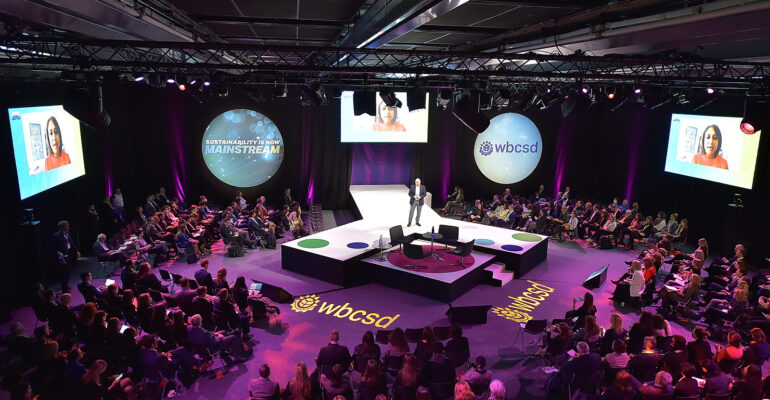Sustainability is now mainstream
“Sustainability is now mainstream” was the theme of the 2022 WBCSD Liaison Delegate Meeting, which took place on April 5 -7 in Montreux, Switzerland. The hybrid event offered exciting sessions around the WBCSD 3 strategic priorities:
- climate emergency,
- nature loss, and
- mounting inequalities
Here is my A-ha! Moments during the conference:
1. Inequality is a systemic risk with a systemic business case
Inequality of income and wealth translates directly into inequality of well-being, contributing to the death of more than 21,000 people a day (OXFAM, 2022). Many systems today demand transformation: decarbonization and energy, food and agriculture, urbanization, digital, and nature and biodiversity; but people left out will not support the change, will not trust in the institutions, and will fuel civil and political unrest, making the crisis worse, and undermining our capacity to tackle the critical challenges.
Businesses have a role to play in addressing inequality. Many may wonder, What is in it for ME?… the wrong question; for now, the systemic problem has a systemic business case, so a better question is, What is in it for the US?: i) we could generate USD 4.56 trillion a year, ii) gender – party improvements by 2030 could add USD 13 trillion to global GDP, iii) up-skilling could boost GDP by USD 6.5 trillion by 2030, iv) diverse, inclusive organizations are 70% more likely to capture new markets. The WBCSD has launched the Business Commission to Tackle Inequality (BCTI) to work more systematically around this issue.
2. We need to do more serious Human Rights work and disclose it adequately
If disclosure is now mainstream, putting the logo and pledging that “the company will incorporate the UN Global Compact ten principles” will not be enough. More than 15,000 companies have committed to the UN Global Compact 10 principles, and sadly only 1% of the 1,000 most influential companies are adequately demonstrating socially responsible business conduct through their disclosure, according to World Benchmarking Alliance (WBA). Notice that this is only disclosure. Eventually, we might need third-party validation.
Having transparent information is a means to an end, so while we are progressing towards the E in ESG, the S in ESG is lagging due to the lack of standards. Lack of standardized disclosure doesn’t mean it is irrelevant; the ecosystem is working towards robust and comprehensive measures. For example, the Task Force on Inequality-related Financial Disclosures (TIFD) was launched, and the EU Social Taxonomy Report is now available.
3. The role of citizens and consumers in the transition is imperative
Businesses, governments, and NGOs have mainly led sustainability. The most recent IPCC report on climate change mitigation identified that the demand side of all sectors has the potential to reduce 40-70% emissions by 2050. And we have heard things like gen-z will reward sustainable companies as consumers or employees; however, I don’t see conversations around how to empower citizens and consumers for sustainability or how companies can engage their consumers to achieve the net-zero goals.
For example, in the Critical Raw Materials (CRMs) sector: according to the IEA report The Role of Critical Minerals in Clean Energy Transitions, an electric vehicle requires six times in weight of the mineral inputs of a conventional car (Lithium, Cobalt, Nickel, Copper, etc.), like other clean power generation devices; so the transition to a low-carbon economy will increase the demand for these rare earths. The extraction of these materials is dominated (30-50%) by some countries like Chile, Indonesia, Congo, and Australia, and processed mainly in China. Yet, this production is not enough today, and the transition action will result in a demand running ahead of supply. This represents a double challenge: i) how to ensure a low-carbon supply of these minerals while ensuring human rights and socio-political stability, and ii) how to ensure the life cycle of these materials will not impact lands, oceans, biodiversity, and human health. This is a vast ecosystem circular economy opportunity where consumers and citizens have a role to play.
4. Standard-setting and reporting initiatives are essential but insufficient
The need for standardized disclosure against ESG performance for investors is increasing. This has been an essential topic around sustainability over the last years. The appetite for ‘What to measure and how to communicate it is now making progress. The European Union taxonomy, SASB, and TFCD frameworks are now available and informing climate regulations; however, more work needs to be done around other environmental aspects, such as circularity and biodiversity, and of course, the S in ESG.
Even if we get the right set of metrics, experience shows that ESG investors need to engage in understanding the whole picture better. We shouldn’t keep only with either ESG rating or reporting to make investment decisions. For example, an NGO listed a France-based electric company in a given ranking; many investors engaged with each one to explain no called the company arguing for disinvestment. Thet only the transition, but the just transition plans. Not all information was publicly available or reflected through their own disclosure or public ESG ratings. If ESG investors need insights, they must also engage with the managers.
5. Risk Of Inaction is also ROI
Measuring and communicating value creation (Return On Investment) or value protection (Risk Of Inaction) around sustainability is a discipline. To move faster, we need to talk more about the financial risks and financial opportunities against the future ambitions of the companies; if we want to grow responsibly, we need to act now. Socially responsible or sustainability strategies should be embedded into the core strategy. Otherwise, it will not work.
For example, PMI is transitioning from cigarettes to inhaled therapeutics and self-care wellness solutions. They have committed to generating at least USD 1 billion in annual net revenues from products that do not contain tobacco or nicotine. If ESG investors move away from PMI, they miss the point: use capital to drive change. With no money, the transition will take longer.



